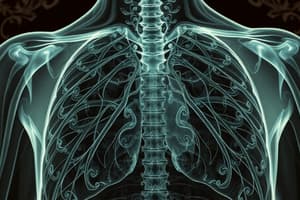Podcast
Questions and Answers
Which imaging modality is NOT typically used for thoracic assessment?
Which imaging modality is NOT typically used for thoracic assessment?
- Radiography
- Electrocardiography (correct)
- Ultrasonography
- Computed Tomography
The normal width of the heart in dogs is greater than 2/3 the width of the thorax.
The normal width of the heart in dogs is greater than 2/3 the width of the thorax.
False (B)
What is the preferred positioning technique for thoracic imaging to avoid axial rotation?
What is the preferred positioning technique for thoracic imaging to avoid axial rotation?
Right lateral positioning
In cats, the normal width for the DV measurement is approximately _____ the width of the thorax.
In cats, the normal width for the DV measurement is approximately _____ the width of the thorax.
Match the following terms with their definitions:
Match the following terms with their definitions:
Flashcards are hidden until you start studying
Study Notes
Imaging the Thorax
- Radiography, ultrasonography, and computed tomography are primary imaging modalities for thoracic evaluation.
- Preferred positioning for radiography is right lateral to avoid axial rotation of the thoracic structures.
- Centering and collimation are crucial to ensure focused images.
- Dorsal-ventral (DV) and ventral-dorsal (VD) views should be aligned to the midline to maintain correct orientation and avoid rotation.
- For optimal exposure, images should be taken at peak inspiration to clearly visualize the diaphragmatic outline.
- Proper labelling of images is essential for clarity in assessment.
- When assessing images, avoid artefacts using the mnemonic: Pink Camels Collect Extra Logs.
Assessing
- Ventral and central veins are key in evaluating vascular anatomy in the thorax.
- Lung anatomy includes examining branching patterns and markings, noting both normal and abnormal features.
- Assess heart anatomy for signs of generalized and chamber-specific enlargement, which can indicate underlying pathology.
Normal Heart
- In dogs, the normal heart width on DV view is approximately two-thirds of the thoracic width.
- In lateral views for dogs, the heart size should occupy between 2.5 to 3.5 intercostal spaces.
- Normal width measurements for cats require additional specification and comparison for accurate evaluation.
Studying That Suits You
Use AI to generate personalized quizzes and flashcards to suit your learning preferences.




